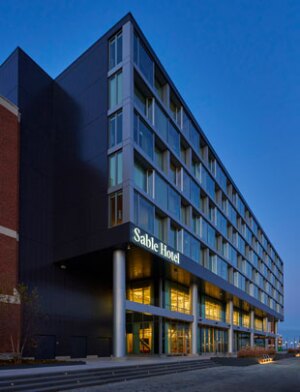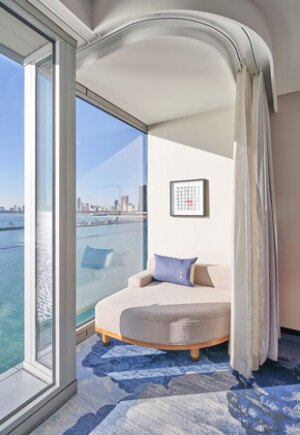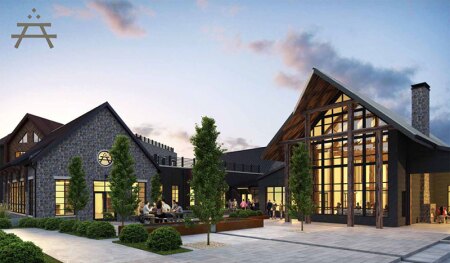It is no secret that hospitality was one of the commercial real estate sectors hardest hit by COVID-19. In fact, hotel occupancy fell to a historic low of 24.5 percent in April 2020 and averaged just 44 percent that year, as compared with 66 percent in 2019, according to the American Hotel and Lodging Association. Despite a historic-low, pandemic-induced hotel occupancy rate of 24.5 percent in April 2020, hotel construction did not come to a standstill.
Indeed, over the past two years, McHugh Construction—a commercial construction firm that has been around 125 years, working through two world wars, the Great Depression, multiple recessions and not just one but now two pandemics—completed several notable hospitality projects, including the Four Seasons Hotel Chicago, where we undertook a full renovation of the iconic, five-star property; Southall, a new 325-acre (131 ha) farm-based resort in Franklin, Tennessee; and Sable at Navy Pier, the first Chicago hotel ever built on top of Lake Michigan.
These jobs in many ways were “once in a lifetime” construction experiences for our team, providing us the opportunity to encounter new challenges, learn valuable lessons, grow our business, and master news skills. And, as the tourism industry today quickly rebounds from the near standstill it experienced in spring 2020, these projects provide valuable insights into the future of the sector that we and our clients will carry with us for years to come.
Lesson 1 – You’re Never Too Early to Plan
Supply chain disruption. Never before have three words so clearly described one of the biggest issues to emerge from the pandemic—one that continues to be a hurdle for almost every construction project today.
In the hotel construction sector specifically, supply chain considerations go beyond the significantly longer lead times now required for essentials like steel and lumber to also include availability of the luxury materials and finishes that are so integral to the unique hotel environments we create for clients. Specialty items have always required more time to procure and ship, but we’re now seeing these timelines double—and even triple—in some cases. The impact of COVID on manufacturing and fabrication time added to the uncertainty of shipping delays and reduced the availability of containers, resulting in a perfect storm.
Besides impacting project timelines, supply chain issues are also being felt in project budgeting. Not only are material costs higher due to limited supply, but shipping costs can also skyrocket unexpectedly due to container and driver shortages as well as rising fuel prices. Just in 2020, the cost of standard shipping container delivery from China increased from approximately $4,000 up to as much as $25,000, a more than 500 percent escalation.
All of this underscores the importance of starting the planning for hospitality projects early, and also bringing your construction partner to the table from day one to vet the design, begin procurement, and track pricing in real time in the event market dynamics shift. Since hospitality projects have a hard opening or turnover date, the construction team has a fixed target to work backwards from—and the more runway we have in terms of getting critical supplies and specialty materials procured, the more flexibility we have to adjust the project schedule or budget if unanticipated issues with pricing or availability arise.
Early planning in the hospitality sector also needs to entail building extra time into the construction schedule in case the unexpected happens.
A great example of this was a rather unusual unforeseen challenge we encountered while constructing Sable at Navy Pier. Together with our joint venture partner Powers & Sons Construction Co., McHugh worked with the Army Corps of Engineers and CDOT Harbor to avoid driving micropiles during the winter so as not to disturb the mudpuppies that reside under the pier during the winter months. These small aquatic salamanders are a protected species in Illinois that live in shallow water and are tracked by researchers to monitor Lake Michigan’s ecosystem. When warm weather returned and the mudpuppies swam to deeper waters, we resumed work beneath the pier. This was hardly a run-of-the-mill construction challenge but given the unusual site and complexity for this project and our previous experience working at Navy Pier, we knew to anticipate the unexpected and had built in flexibility so we were able to respond accordingly when safeguarding animals became a factor in the project’s timeline.
Lesson 2 – From “Road Warrior” to “Bleisure Traveler”
Even as business travel recovers from the initial impact of the pandemic—the Global Business Travel Association predicts a return to pre-COVID levels by 2024—ongoing shifts in business practices that were accelerated by the pandemic are directly impacting tomorrow’s hospitality trends and hotel projects.
Specifically, today’s workforce enjoys more flexibility than ever before thanks to hybrid work schedules and the widespread adoption of tools like Teams and Zoom that allow people to connect from anywhere. While “road warriors” will certainly always exist, the new “work from wherever” freedom many employees now have is fueling a rise in “bleisure” travel—business trips with personal time tacked on—as well as working vacations where travelers plan to spend at least some time checking in with the office.
Broadly, that results in hotel projects less targeted to the traditional business traveler and instead offering a luxury lifestyle atmosphere that in some ways reflects the casual work-from-home environment we’ve all become accustomed to. For example, at Sable Hotel, the design by KOO Architecture offers lounge seating against floor-to-ceiling windows facing south with a view to Chicago’s beautiful skyline over Lake Michigan in each guestroom. The thoughtfully designed space allows one guest to sit with their laptop and soak up the morning sun and views, and draw a curtain to create privacy from the rest of the room so as not to disturb their partner who may want to sleep in.
Common areas also encourage guests to linger longer, whether they are socializing or conducting business. At Four Seasons Hotel Chicago, we executed interior design firm Rottet Studio’s vision of contemporary luxury, including a lighter color palette and an open floor plan. A day bar and a social lounge with varied seating areas create a sophisticated yet inviting living room vibe.
This shift is also leading to a move from full-service hotels with traditional banquet facilities, conference centers, and amenities. Instead, we’re seeing more projects that offer an experiential stay built on a unique concept—such as Southall, the farm-based Inn and Spa we are currently building near Nashville, Tenn. After the pandemic, everyone wants something unique and fresh out of their hotel stay— whether for business or pleasure—and the type of targeted concept offered by properties like Southall speak to the desire among today’s travelers for authentic and unique experiences.
Lesson 3 – The Changing Language of “Modern” Luxury
“Luxury” has always been a nuanced word, but there’s a growing shift in how it is interpreted in hotel projects. From the use of natural elements and materials to aesthetics that are more modern and contemporary to the varied amenity offerings of resort properties, the vernacular of the traditional five-star hotel environment is broadening. While we were tracking this trend pre-2020, we expect it will only accelerate thanks to the growing shifts in lifestyles and priorities that came about in the last two years.
Southall in Tennessee is an excellent example of the type of five-star resort projects we anticipate seeing more of in the coming years. Located in the rolling hills just south of Nashville, the property is a world-class retreat completely immersed in nature. The interior design from Indidesign provides an “inside-out” natural sensation throughout, from the materials used in construction to the flow between indoor and outdoor spaces to amenities such as a signature farm-to-table restaurant and a spa that offers holistic treatments, hiking, and hilltop yoga.
From a construction standpoint, projects like Southall often require the use of alternative materials or call on the GC to incorporate new construction methods to achieve their unique aesthetic. For example, the exterior design from 906 Studio Architects for Southall’s four inter-connected buildings called for construction with sustainable wood materials, including cross-laminated timber, using a heavy timber construction technique for framing rather than the more typical concrete and steel. While this added a level of complexity to the project, the payoff in this case was to elegantly deliver the farm look the client desired as well as reaping the sustainability benefits of these materials.
It’s worth noting that no matter how the aesthetic of luxury may change, the level of craftsmanship and the look and feel of finishes is always going to be one of the most critical aspects of creating any luxury hospitality environment. From the general contractor’s perspective, that makes several things imperative:
- Having a wide network of trusted subcontractors and tradespeople to call on to execute those unique touches and work with specialty materials.
- Knowing how and where to value engineer luxury finishes. Case in point: the “touch” of stone is as important as the visual, so substituting a less costly material with a similar look isn’t an option unless it’s eight feet off the ground or otherwise out of reach of guests.
Providing input to clients on durability and maintenance requirements of materials they are considering. A beautiful feature that’s fantastic in a residential setting—such as etched or beaded glass in shower enclosures—won’t stand up to the maintenance requirements of a guest room that gets significantly heavier use. An experienced contractor is a resource to identify those issues in the planning phase and suggest alternatives.

The newly renovated Four Seasons Hotel Chicago features lighter colors and an open floor plan throughout the lobby that invites guests to linger for socializing and live entertainment. McHugh Construction served as general contractor, and Rottet Studio served as architect. (Four Seasons Hotel Chicago)
Lesson 4 – Do Not Disturb: Minimizing Guest Impact During Hotel Renovations
Whether traveling for business or pleasure, nobody wants to stay in a hotel that’s a loud, intrusive construction site. This became even more critical during the pandemic as lines were blurred at home between school time, family time and work – making the peace and quiet of a hotel stay a precious commodity. Hand-in-hand with minimizing disruption to the guest experience is public safety considerations, which is always our top priority on any construction site.
All of this makes balancing construction with hotel operations one of the most important aspects of renovating an occupied hotel, as we did with the Four Seasons Hotel Chicago. Ensuring our clients can still function as a luxury hotel and cater to their guests’ expectations, even during construction, involves plenty of give and take over multiple meetings to find the sweet spot. Some key considerations:
- Strategic timing of inconveniences: Hotel renovations often entail careful scheduling and use of overtime shifts to avoid things such as shutting off water during peak usage hours.
- Vetting craftsmen and trades: Luxury hotel renovations require not only the highest execution of work, but also enlisting subcontractors we trust to be sensitive in a hotel environment—from minimizing noise to maintaining an impeccably clean job site.
- Getting creative with camouflage: When separating construction areas from front-of-house spaces, we created temporary partitions designed to look like a permanent part of the space to block off an area under construction—ensuring guest safety and also disguising the work site.
- Knowing when to close: In renovating the sky lobbies of the Four Seasons as well as another five-star hotel in Chicago, it became apparent after reviewing multiple options that there was no way to accomplish our work without severely impacting the arrival experience of guests or impeding their path to the elevators. We advised these clients on the decision to execute a short (fewer than 30 days) shutdown during the lowest occupancy period (which in Chicago is typically January), and we worked out a plan to ensure we procured all materials and sufficient manpower to work two, sometimes three shifts to complete this portion of the renovation while the hotel was unoccupied.
The lessons above illustrate that the one constant in the hospitality sector is change—whether it’s caused by a major force like a pandemic, or simply the gradual shifts that come in any industry as new ideas and trends are broadly adopted. While it’s important to learn from history and look back on these projects, we’re also focused on the future. One thing we know will be shaping hotel construction for the next decade is the rise in younger travelers—digital natives who embrace technology in nearly every aspect of their lives and appreciate the convenience and environmental benefits tech features can offer in a hotel setting. Right now, we’ve only scratched the surface with touchless tech in hotel projects, such as keyless entry systems, wireless thermostats tied to occupancy sensors, motion detectors that can automatically switch to an energy saving setting when a room isn’t occupied, and room controls in a tablet at your fingertips or even voice control … what will be next? As the hotel sector continues to evolve, we look forward to working with our clients to address the changing preferences of their clientele and bring unique hotel experiences to life for another 125 years.
KATE IVANOVA is vice president of McHugh Construction.







